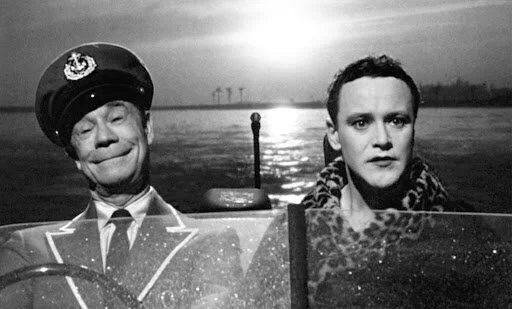#45: Some Like It Hot
Release Date: March 29th, 1959
Format: Theater (The Frida Cinema in Santa Ana, CA)
Written by: I.A.L. Diamond and Billy Wilder
Directed by: Billy Wilder
4 Stars
I’m embarrassed to admit how little of Billy Wilder’s filmography I’ve seen. This is the first time that I've seen Some Like It Hot. Additionally I’ve seen Wilder’s Double Indemnity, Sunset Boulevard, and The Apartment, all of which I think are excellent. But this leaves out other Wilder films such as The Lost Weekend, Ace in the Hole, Stalag 17, Sabrina, Fortune Cookie, etc etc etc (he made lots of movies).
There just weren’t any Wilder films at my mom’s or dad’s houses. And if I’m a teenager at the video store in the late ‘90s/early ‘00s, I’m not reaching for a black and white Jack Lemmon-in-drag movie (at this point I knew him as one of the old guys in Grumpy Old Men). I don’t care how funny the boomers tell me it is.
Well, Some Like It Hot is that funny. And well-constructed. Now that my Wilder viewing is up to four films, the thing that stands out the most about them is the quality of their construction. The beats are right, the performances are memorable, and the scripts are lean. There is no fat on the bone. The pace, especially for ‘40s and ‘50s films, is brisk and efficient. As a viewer, you just find yourself at total ease while watching a Wilder film. He’s got it, I can relax.
And laugh. Some Like It Hot has tons of laughs. D and I saw it at The Frida Cinema in front of a packed house and it came alive on the big screen. It sparked. It’s an original, high-concept comedy with big stars and smart, but always silly, hijinks.
It’s a dead genre, which is sad. I mentioned this similar type of sadness in my review of The Rock (#42), an action movie with practical effects and on-location shooting in downtown San Francisco and Alcatraz. I wrote that it’s not economically feasible to shoot a movie like that anymore, to the detriment of fans of action movies.
The production costs of Some Like It Hot are perfectly feasible economically today, that’s not the problem. So why don’t they make high-concept comedies like this anymore? I’m not sure there are filmmakers and writers that are funny enough to make them. Or maybe they are being made, but they’re not funny and make no cultural impact. It’s not a big mystery to me why comedy has migrated away from the big screen in the 2020s to stand-up comedy, which is as big as it’s been since the 1980s. Comedy on film is difficult.
Imagine putting, let’s say, Timothee Chalamet and Daniel Radcliffe in drag as two down-on-their-luck musicians trying to play in an all-women jazz band. It’s an insane high wire act for any director and it would need an airtight script. The risk to reward ratio is awful, and you could imagine it immediately getting roasted on social media and meme’d to death on the internet.
You might be asking, but what about Barbie? Is that not a high-concept comedy, that took artistic and comedic risks, that was funny, that made a cultural impact? Yes, it was. I suppose it was the exception that proves the rule, and it’s partly why that movie was a huge success. There is an appetite for well-written, original comedies, but they’re risky to make and let’s face it, nobody likes to bomb. A mediocre drama can be politely tolerated in a theater, but a mediocre comedy can make you wince. Maybe Barbie’s success will open the door to other creative, risk-taking comedies. Hopefully.
In my research of Some Like It Hot, I came across a Billy Wilder interview where he said he makes his movies for himself and his ten best friends, and that anyone that sets out to make a hit for the public is only sacrificing their soul. In 2024, in the competition for clicks and likes and the international market, this seems like a quaint thought. And ironic, since a dozen Wilder movies have lived on in the public consciousness for decades.
